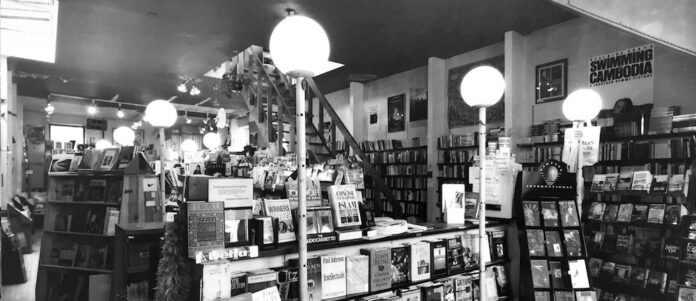
The original Barbara’s at 1434 Wells Street in Old Town was in an ancient three-story with two apartments above the store. When I came to Barbara’s in the late 60s, we expanded to the second floor, built a steep and precarious staircase in the middle of the store to get to it, and used the new space for a little more book store and an office.
Our daughter Rebecca was born in 1975.
She lay in a crib in a side room of the upstairs office while her mother Jan met with publisher representatives and occasional authors to buy titles for the store.
I remember Joseph Heller sitting at her desk and signing books because he was dreading the trip down the stairs to read to the gathered audience.
Jerzy Kosinski, Studs Terkel, Susan Sontag, Tom Wolfe were among the many who made their way up the stairs. So did lesser known but dedicated book travelers, mostly men and very few women, who worked for publishers and tried to convince Jan that their titles were worthy of attention.
We were in the office one afternoon when we heard a thunderous explosion that went on for a while. The building remained standing so we made our way down the stairway to discover that the entire three-story wooden back porch structure had collapsed to the ground.
No one was on it or in it, but it took out the store’s phone lines, and the air conditioner and the window where it sat. The life-sized poster of Vladimir Lenin that was pasted to the back wall remained whole. The porch’s downfall was a sign that the creaking floors, flickering light poles, pigeon excrement-specked entrance, and the bowed and splintered bookshelves had perhaps gotten past their expiration dates.
Nonetheless, we stayed in place until 1984. Sometime that year, Pat Peterson, our general manager and friend, told us about a nightmare she had had.
In her dream, Yiddish writer Isaac Bashevis Singer, the elderly distinguished winner of the Nobel Prize in Literature, went to the second floor bathroom prior to his appearance at a signing. Firmly seated on the toilet, he crashed through the ceiling and landed upright in the middle of the assembled audience.
After that horrible and plausible dream, we moved a half-block south on Wells Street to the recently converted Dr. Scholl’s foot factory complex renamed Cobbler Square.
We built a second Barbara’s in 1971 at 2907 North Broadway. It happened mostly because we had too many serious booksellers on Wells Street who were getting in each other’s way. Disagreements about books and politics can get dangerous.
Barbara’s on Broadway and its next door neighbor, The Great Frame Up, opened within a couple of days of each other. It was The Great Frame Up’svery first store and it grew to a couple of hundred. Barbara’s seemed to inspire start-up retailers that went on to far greater fame. Crate & Barrel opened its first store a few doors down from us on Wells Street.
I witnessed the actual packing crates and barrels that served as its display fixtures – a cheap way in December of 1962 for very young Gordon and Carole Segal to outfit their small space.
Another favorite in the roll call of disasters began one day in the early 70s. It was the time to ‘make love not war’, a phrase that an early part-time Barbara’s person, Franklin Rosemont, was credited with popularizing. It was a time when we had a young bookseller whose given name was Sunshine. (That was the 70’s.) I walked into the Broadway store and noticed a suicide joke posted to the cash register and a look of despair on the faces of our staff. It took some lawyerly questioning, but I uncovered the cause of the ticking doom clock. It was revealed to me, as it necessarily had been to the staff, that one of our booksellers had been diagnosed with gonorrhea, inelegantly referred to as “the clap.”
The infected carrier had been intimate with bookseller A, who had, in turn, “done it” with bookseller B, who had slept with booksellers C and D, etc.
One more existential crisis played out in the late 70s. During a brutally cold winter dusk, the Wells Street furnace went dead. Inside the store, the temperature descended towards zero, and over the next couple of days all of the books began to freeze and visibly curl. We were done for; the end of Barbara’s. All of our inventory in ruins.
We located our longtime janitor Zollie at the nearby bar, where he could frequently (well, always) be found. He greeted us with his eternal invocation, “Putty good.” But it wasn’t. We walked him to the store, where he soon agreed that outside help was needed.
Late into the next night and early morning, Zollie and I watched as the plumber, coughing, blowing on his fingers, and swearing, attempted to blow-torch the frozen pipes in the basement. It was beyond cold in the dark and frightening place that could have easily been a venue for a Stephen King story. But the brave plumber got the furnace working and the pipes flowing, and the store began to warm.
Improbably, the books began to uncurl and more or less return to their former pristine state. This was a process that seemed a miracle and which, to this day, I do not understand. Barbara’s was saved to stumble on through the rest of the 20th and now 21st centuries.
Friends and strangers, I need your help recalling
